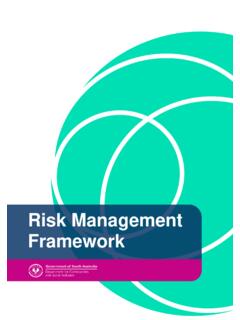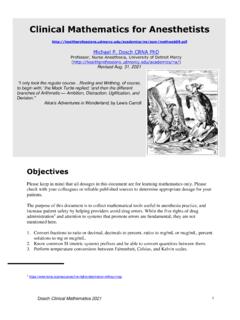Transcription of COVID-19 Fact Sheet Cleaning and disinfection in the workplace
1 COVID-19 Fact Sheet Cleaning and disinfection in the workplace This Fact Sheet provides information on Cleaning workplaces (non-health care settings) during the coronavirus ( COVID-19 ) outbreak. This includes offices, public areas, government buildings, reception areas, schools, child-cares, shops, buses, trains, taxis and cars. Thorough Cleaning followed by disinfection is required to remove the virus that causes COVID-19 . Make sure to clean and remove any organic matter first prior to disinfection , as disinfectants will not work on a dirty surface. The length of time that COVID-19 survives on surfaces will vary depending on factors such temperature and humidity and the amount of contaminated body fluids present, such as respiratory droplets. Coronaviruses are unlikely to survive for long once droplets produced by coughing or sneezing dry out.
2 General Cleaning principles Cleaning before disinfection is very important as organic matter and dirt can reduce the disinfectant s ability to kill germs. Cleaning with detergents alone does not kill germs or COVID-19 , but physically reduces germs, dirt and organic matter from surfaces. Detergent solutions are Cleaning agents commonly available as powders or concentrated solutions . disinfection using chemicals will kill germs on surfaces. This process kills germs that remain on surfaces after Cleaning , disinfection further reduces the risk of spreading infection. Routine Cleaning It is recommended to increase the occurrence of Cleaning in all areas, including workplaces, to at least daily. This is especially important for high traffic areas and areas accessed by the public. It is recommended that individual workstations be cleaned at least twice daily.
3 It is best practice to: routinely clean frequently touched surfaces and fittings with detergent solution clean surfaces as needed when they are visibly soiled and immediately after any spillage. COVID-19 Fact Sheet Cleaning and disinfection in the workplace Routine Cleaning requirements can be divided into two groups. 1. Frequently touched surfaces: door handles, handrails, bedrails, tabletops, kitchen surfaces, cupboard handles, elevator buttons, computer keyboards, mice, telephones, light switches Should be cleaned frequently. Workplaces should promote a good state of tidiness and de-clutter to ensure Cleaning can be undertaken most effectively. This includes around workstations so that desks, keyboards, telephones etc. can be cleaned easily. Staff should be encouraged to declutter their workstation at the end of each day.
4 Detergent solution (as per manufacturer s instructions) can be used, with the exact choice of detergent determined by the nature of surface and degree of contamination. Detergent-wipes may be used but should not be used as a replacement for the routine mechanical Cleaning (rubbing) of the surface with detergent and water. 2. Minimally touched surface: floors, ceilings, walls, blinds Detergent solution/wipes (as per manufacturer s instructions) are adequate for Cleaning general surfaces and non-patient care areas. Damp mopping is preferable to dry mopping. Walls and blinds should be cleaned when visibly dusty or soiled. Window curtains should be regularly changed in addition to being cleaned when soiled. Sinks and basins should be cleaned on a regular basis. Additional advice on environmental Cleaning is also available from the Australian Government Department for Health Environmental Cleaning and disinfection principles for COVID-19 .
5 If a worker is a suspected or confirmed case, the affected area/workstation should be closed off. If possible, open outside doors and windows to increase air circulation and then begin Cleaning and disinfection . Information for those Cleaning and disinfecting How to clean and disinfect Wear gloves when Cleaning and disinfecting. Gloves should be discarded after each clean. If it is necessary to use reusable gloves, gloves should only be used for COVID- 19 related Cleaning and disinfection and should not be used for other purposes. Wash reusable gloves with soap and water after use and leave to dry. Clean hands immediately after removing gloves. Thoroughly clean surfaces using detergent and water. Apply disinfectant to surfaces using disposable paper towel or a disposable cloth. If non-disposable cloths are used, ensure they are laundered and dried before reusing.
6 Ensure surfaces remain wet for the period of time required to kill the virus (contact time) as specified by the manufacturer. If no time is specified, leave for 10 minutes. COVID-19 Fact Sheet Cleaning and disinfection in the workplace Safety and Personal Protective Equipment (PPE) The risk when Cleaning is not the same as the risk when face-to-face with a sick person who may be coughing or sneezing. If there is visible contamination with respiratory secretions or other body fluid of a suspected or confirmed case, cleaners should wear a full length disposable gown in addition to the surgical mask, eye protection and gloves. This advice should be taken in conjunction with advice from your work health and safety on correct procedures for wearing PPE. Those Cleaning should: Avoid touching their face, especially their mouth, nose, and eyes when Cleaning .
7 Wear water-proof disposable gloves and a surgical mask as well as eye protection or a face shield while Cleaning . The surgical mask and eye protection act as barriers to people inadvertently touching their face with contaminated hands and fingers, whether gloved or not. Use an alcohol-based sanitiser before putting on and after removing gloves and before and after removing the surgical mask and eye protection. Choosing the disinfectant solution The disinfectant used should be one for which the manufacturer claims antiviral activity meaning it can kill the virus (such as chlorine-based disinfectants, hospital-grade disinfectants, or alcohol solutions with at least 70% alcohol (for example, methylated spirits). Household bleach is an effective disinfectant and comes in a variety of strengths. The concentration of active ingredient can be found on the product label.)
8 Quaternary ammonium compounds, such as benzalkonium chloride and related compounds, have a dual detergent and disinfection property and can be suitable alternatives. Preparing the disinfectant solution Gloves should be worn when handling and preparing disinfectant solutions . Protective eye wear should be worn in case of splashing. Follow manufacturer s instructions for appropriate dilution and use. Table 1 below provides dilution instructions when using bleach solutions . Bleach solution should be made up daily. Table 1. Recipes to achieve a 1000 ppm ( ) bleach solution Original strength of bleach Disinfectant recipe volume in standard 10L bucket % Parts per million Parts of bleach Parts of water 1 10,000 1 9 1000ml 2 20,000 1 19 500ml 3 30,000 1 29 333ml 4 40,000 1 39 250ml 5 50,000 1 49 200ml COVID-19 Fact Sheet Cleaning and disinfection in the workplace Using the disinfectant solution Sufficient time is required to kill the virus, , at least 10 minutes contact time.
9 Use the freshly made disinfectant solution and wipe the area with bleach solution using disposable paper towels or a disposable cloth. Dispose of gloves and mask in a leak proof plastic bag. Wash hands well using soap and water and dry with disposable paper or single-use cloth towel. If water is unavailable, clean hands with alcohol-based hand rub. Bleach solution should be used mainly on hard, non-porous surfaces (can damage textiles and metals). Soft furnishings or fabric covered items (for example, fabric covered chairs or car seats) that cannot withstand the use of bleach or other disinfectants or be washed in a washing machine, should be cleaned with warm water and detergent to remove any soil or dirt then steam cleaned. Use steam cleaners that release steam under pressure to ensure appropriate disinfection .
10 Management of linen, crockery and cutlery If items can be laundered, launder them in accordance with the manufacturer s instructions using the warmest setting possible. Dry items completely. Do not shake dirty laundry as this may disperse the virus through the air. Wash crockery and cutlery in a dishwasher on the highest setting possible. If a dishwasher is not available, hand-wash in hot soapy water. Hand hygiene Clean hands help to reduce environmental contamination. Soap and water should be used for hand hygiene when hands are visibly soiled and alcohol-based sanitiser at other times ( when hands have been contaminated from contact with surfaces). How can we help prevent the spread of COVID-19 ? Practising good hand and sneeze/cough hygiene is the best defence against most viruses. You should: Wash hands frequently with soap and water, before and after eating, and after going to the toilet.





